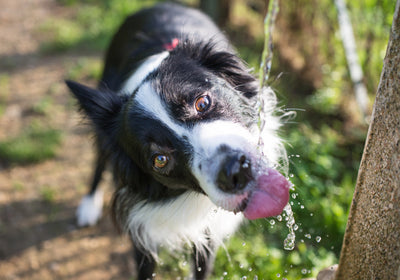How DNA Testing Is Leading To Healthier Dogs

The average dog owner probably first heard about DNA testing a few years back when companies started to advertise testing as a way to learn what breeds your mixed-breed dog was made of. It was touted as more of a novelty or something one could do for fun. Some even questioned their reliability.
But DNA testing is actually a very serious researching tool that can help veterinarians, breeders and dog owners select for healthier dogs. It has been in use for years, with some breeds already starting to see the results.
Kennel clubs and breed registries around the globe all are working with their own partnerships doing their own research, some focusing on similar tests but with different agendas. In addition, there are other organizations, such as the Doberman Diversity Project, that are non-profits working independently or in partnership with kennel clubs to research a specific breed.
In the case of the Doberman, the problem is lack of genetic diversity. According to the Doberman Diversity Project’s website, “Modern Dobermans — whether in Europe, America or Asia — are remarkably genetically similar to one another. Their close genetic relationships further concentrate the genetic mutations behind life-threatening genetic disease — disease that is very serious and often cannot be effectively treated or cured.” University of California, Davis, also did a study on the Doberman’s genetic diversity and found the same issue – they just don’t have enough variety in the gene pool.
Dobermans suffer from many, life-threatening genetic diseases, including Dilated Cardiomyopathy (DCM), Wobbler Disease, hepatitis (inflammation of the liver), and cancer. The lack of genetic diversity in the Doberman’s case was actually created by the well-intentions of breeders trying to remove diseases from the lines, but without the advancement of DNA testing, the result was lack of a good gene pool with the diseases still present. Now, however, DNA testing can help Dobie breeders match dogs that are far as away genetically as possible, but also are not carrying genetic diseases.
Even if your breed has plenty of diversity, knowing what disease your lines have and lines you want to breed to, help make sure you do not create a problem by breeding dogs that have genetic diseases. For example, the GoldenDNA.org site is mapping out genetic DNA test results for Golden Retrievers. They have found that some progressive retinal atrophy (PRA) can be found via DNA testing if it’s linked to progressive rod cone degeneration (prcd). Dogs can be carriers of prcd-PRA, meaning that if they are bred to a dog that is clear, the puppies will be carriers as well, but not have the disease. HOWEVER, if bred to another dog that is also a carrier, a percentage of the puppies will have it. Not only does this testing help avoid the second scenario, it also allows researchers to see where the diseases are more prevalent in terms of geography. In the case of prcd-PRA in goldens, they have seen quite a few cases of prcd-PRA in American Goldens, but in Swedish Goldens, those with PRA do not have prcd, but other forms of the disease. This information can help pinpoint causes of diseases, but also help breeders when selecting where to breed if they are looking at importing.
Other research projects are focuses on the diseases, to see which breeds they are more prevalent in. The Australian National Kennel Council Ltd. (ANKC) was conducting genetic research on canine hip and elbow dysplasia and canine eye diseases, across breeds. Once results are in, breed or kennel clubs can then know if they need to research that disease more at their breed level.
To encourage DNA testing and healthy breeding practices, the ANKC Ltd. has introduced Litter Registration Limitations (LRL). Golden Retrievers, German Shepherds and Rottweilers, for example, need to be tested for hip dysplasia, as their research has shown its prevalent in these breeds. If you are breeding and you do not test your breeding dogs, your litters cannot be registered. Other breeds that are or will have LRLs soon are Irish Setters for CLAD, Bedlington Terriers for copper toxicosis, and for Border Collies, Ceroid-Lipofucinosis (dogs with CL do not live past the age of 2.5 years).
There are hundreds of genetic diseases across dog breeds. For example, while the ANKC is looking at CL in Border Collies, there are actually a total of 7 DNA testable diseases in this breed that should be checked for – TNS (Trapped Neutrophil Syndrome), CL (Ceroid Lipofuscinosis or Storage Disease), CEA (Collie Eye Anomoly), Goniodysgenesis (pre-disposition to glaucoma), MDR1 (Multi Drug Resistance gene), Imerslund-Gräsbeck Syndrome (Cobalamin Malabsorption or Vitamin B12 Deficiency) and SN (Sensory Neuropathy).
The American Kennel Club Health Foundation has a useful database where you can search by breed for which tests should be performed as well as the health statistics for that breed. They list over 119 genetic tests, with more being added all the time (www.ofa.org).
I am Not a Breeder, Why Should I Care?
Even if you are not a breeder, you should be deeply interested in these genetic tests and only go to breeders that participate in these studies when looking for your next dog. Why? Because puppies that are the product of dogs selectively chosen for temperament, conformation AND have been genetically screened are much more likely to produce puppies that have a good temperament, nice conformation, AND that are free of genetic disease. Most genetic disease are life-long issues that can cost thousands at the vet, limit your dog’s ability to do certain things and/or shorten his life. So, whether you are looking to breed or pick out your next puppy, look up common genetic disease and ask the breeders about what testing they have done. In the long run, it will make for a happier dog ownership, for both you and your future best friend.








